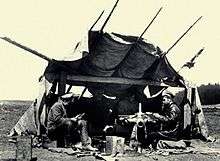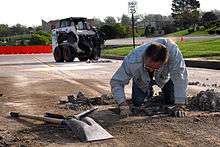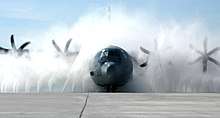Maintenance (technical)


The technical meaning of maintenance involves functional checks, servicing, repairing or replacing of necessary devices, equipment, machinery, building infrastructure, and supporting utilities in industrial, business, governmental, and residential installations.[1][2] Over time, this has come to often include both scheduled and preventive maintenance as cost-effective practices to keep equipment ready for operation at the utilization stage of a system lifecycle.
The marine transportation,[3] offshore structures,[4] industrial plant and facility management industries depend on maintenance, repair and overhaul (MRO) including scheduled or preventive paint maintenance programmes to maintain and restore coatings applied to steel in environments subject to attack from erosion, corrosion and environmental pollution.[4]
Definitions

Over time, the terminology of maintenance and MRO has begun to become standardized. The United States Department of Defense uses the following definitions:[5]
- Any activity—such as tests, measurements, replacements, adjustments, and repairs—intended to retain or restore a functional unit in or to a specified state in which the unit can perform its required functions.[5]
- All action taken to retain material in a serviceable condition or to restore it to serviceability. It includes inspections, testing, servicing, classification as to serviceability, repair, rebuilding, and reclamation.[5]
- All supply and repair action taken to keep a force in condition to carry out its mission.[5]
- The routine recurring work required to keep a facility (plant, building, structure, ground facility, utility system, or other real property) in such condition that it may be continuously used, at its original or designed capacity and efficiency for its intended purpose.[5]
Maintenance is strictly connected to the utilization stage of the product or technical system, in which the concept of maintainability must be included. In this scenario, maintainability is considered as the ability of an item, under stated conditions of use, to be retained in or restored to a state in which it can perform its required functions, using prescribed procedures and resources.[6][7]
In some domains like aircraft maintenance, terms maintenance, repair and overhaul[8] also include inspection, rebuilding, alteration and the supply of spare parts, accessories, raw materials, adhesives, sealants, coatings and consumables for aircraft maintenance at the utilization stage. In international civil aviation maintenance means:
- The performance of tasks required to ensure the continuing airworthiness of an aircraft, including any one or combination of overhaul, inspection, replacement, defect rectification, and the embodiment of a modification or a repair.[9]
This definition covers all activities for which aviation regulations require issuance of a maintenance release document (aircraft certificate of return to service - CRS).
Types
The basic types of maintenance falling under MRO include:
- Preventive or scheduled maintenance, where equipment or facilities are inspected, maintained and protected before break down or other problems occur.
- Corrective maintenance where equipment is repaired or replaced after wear, malfunction or break down.
- Predictive maintenance, which uses sensor data to monitor a system, then continuously evaluates it against historical trends to predict failure before it occurs.[10]
Architectural conservation employs MRO to preserve, rehabilitate, restore, or reconstruct historical structures with stone, brick, glass, metal, and wood which match the original constituent materials where possible, or with suitable polymer technologies when not.[11]
Preventive

Preventive maintenance is maintenance performed with the intent of avoiding failures, safety violations, unnecessary production costs and losses, and to conserve original materials of fabrication. The effectiveness of a preventive maintenance schedule depends on the RCM analysis which it was based on, and the ground rules used for cost efficacy.[12]
Corrective
Corrective maintenance is a type of maintenance used for equipment after equipment break down or malfunction is often most expensive – not only can worn equipment damage other parts and cause multiple damage, but consequential repair and replacement costs and loss of revenues due to down time during overhaul can be significant. Rebuilding and resurfacing of equipment and infrastructure damaged by erosion and corrosion as part of corrective or preventive maintenance programmes involves conventional processes such as welding and metal flame spraying, as well as engineered solutions with thermoset polymeric materials.[13]
Predictive
More recently, advances in sensing and computing technology have given rise to predictive maintenance. This maintenance strategy uses sensors to monitor key parameters within a machine or system, and uses this data in conjunction with analysed historical trends to continuously evaluate the system health and predict a breakdown before it happens.[10] This strategy allows maintenance to be performed more efficiently, since more up-to-date data is obtained about how close the product is to failure.[14]
See also
| Look up repair or revamping in Wiktionary, the free dictionary. |
- Auto maintenance
- Darning
- Design for repair
- Kludge
- Logistics center
- Maintainability
- Product lifecycle
- RAMS
- Reliability engineering
- Remanufacturing
- Scheduled maintenance
- Total productive maintenance
- Repair, in medicine, according to the ICD-10-PCS, in the Medical and Surgical Section 0, root operation Q, means restoring, to the extent possible, a body part to its normal anatomic structure and function. This definition, repair, is used only when the method used to accomplish the repair is not one of the other root operations. Examples would be colostomy takedown, herniorrhaphy of a hernia, and the surgical suture of a laceration.
References
- ↑ "Defense Logistics Agency". DLA.mil. Retrieved 5 August 2016.
- ↑ "European Federation of National Maintenance Societies". EFNMS.org. Retrieved 5 August 2016.
All actions which have the objective of retaining or restoring an item in or to a state in which it can perform its required function. The actions include the combination of all technical and corresponding administrative, managerial, and supervision actions.
- ↑ Berendsen, A. M.; Springer (2013). Marine Painting Manual (1st ed.). ISBN 978-90-481-8244-2.
- 1 2 ISO 12944-9:2018 – Paints and Varnishes – Corrosion Protection of Steel Structures by Protective Paint Systems – Part 9: Protective Paint Systems and Laboratory Performance Test Methods for Offshore and Related Structures
- 1 2 3 4 5 Federal Standard 1037C and from MIL-STD-188 and from the Department of Defense Dictionary of Military and Associated Terms
- ↑ "AAP-6 - Glossary of terms and definitions". NATO Standardization Agency. North Atlantic Treaty Organization: 158.
- ↑ "Commercial Electrical Contractor and Domestic Electrician Leeds". 247 Electrical Services Leeds. Retrieved 2017-01-26.
- ↑ United States Code of Federal Regulations Title 14, Part 43 - Maintenance, Preventive Maintenance, Rebuilding, and Alteration
- ↑ Airworthiness Manual, Doc 9760 (3 ed.). Montreal (Canada): International Civil Aviation Organization. 2014. p. 375. ISBN 978-92-9249-454-4.
The Airworthiness Manual (Doc 9760) contains a consolidation of airworthiness-related information previously found in other ICAO documents ... provides guidance to States on how to meet their airworthiness responsibilities under the Convention on International Civil Aviation. This third edition is presented based on States' roles and responsibilities, thus as State of Registry, State of the Operator, State of Design and State of Manufacture. It also describes the interface between different States and their related responsibilities. It has been updated to incorporate changes to Annex 8 to the Chicago Convention — Airworthiness of Aircraft, and to Annex 6 — Operation of Aircraft
- 1 2 Garcia, Mari Cruz; Sanz-Bobi, Miguel A.; Del Pico, Javier (August 2006), "SIMAP: Intelligent System for Predictive Maintenance: Application to the health condition monitoring of a windturbine gearbox", Computers in Industry, 57 (6): 552–568, doi:10.1016/j.compind.2006.02.011
- ↑ Horie, Charles Velson (2010). Materials for Conservation: Organic Consolidants, Adhesives and Coatings (2nd ed.). Butterworth-Heinemann. ISBN 978-0-75-066905-4.
- ↑ "RCM Reliability Centered Maintenance Analysis". MTain.com. Retrieved 5 August 2016.
- ↑ Industrial Polymer Applications: Essential Chemistry and Technology (1st ed.). United Kingdom: Royal Society of Chemistry. 2016. ISBN 978-1782628149.
- ↑ Kaiser, Kevin A.; Gebraeel, Nagi Z. (12 May 2009), "Predictive Maintenance Management Using Sensor-Based Degradation Models", IEEE Transactions on Systems, Man, and Cybernetics - Part A: Systems and Humans, IEEE, 39 (4): 840–849, doi:10.1109/TSMCA.2009.2016429